Hundertwasser Toilets
The Hundertwasser Toilets is a public toilet located at 60 Gillies Street, the main street of the town of Kawakawa in northern New Zealand. The structure was completed in 1999 and named after the architect and visual artist Friedensreich Hundertwasser, who conceived and designed the project. It is one of the few toilet blocks worldwide seen both as an international work of art[1] and a tourist attraction in its own right.[2]
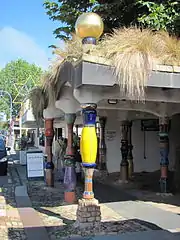
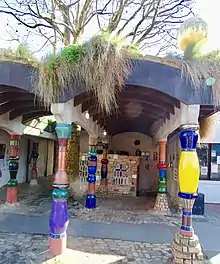
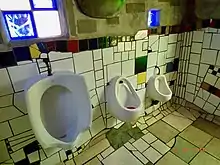
Description
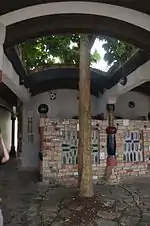
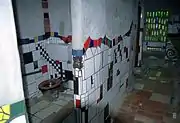
The toilet facility was designed by the reclusive Austrian and New Zealand artist Friedensreich Hundertwasser, who lived near Kawakawa from 1975 until his death in 2000, aged 71.[3] The decorative toilet block is the only project designed by Hundertwasser in the Southern Hemisphere and the last project completed within the artist's lifetime.[4] The style is typical Hundertwasser, with wavy lines, irregular ceramic tiles, integrated small sculptures, coloured glass and a live tree incorporated into the architecture.
Recycled materials, including the community's spent glass bottles and bricks from a former Bank of New Zealand branch, were used throughout.[5][6] Hundertwasser requested that any vegetation removed for construction should be replanted on the building's green roof.[7] The toilet was opened in 1999. Functionally, it does not differ from other ordinary public toilets. There are separate men's and women's areas, but both sides are sometimes viewed by the more curious visitor after giving suitable advance warning.[8]
Tourism
The Hundertwasser Toilets are considered the main attraction of Kawakawa[9] and the most photographed toilet of New Zealand.[10] The bus-loads of tourists who view the toilets far outnumber the individuals who visit simply to use the facility.[11]
References
- Kisch, Conrad (2009). Destination. New Zealand. Gyldendal Uddannelse. p. 56. ISBN 978-87-02-07584-7.
- House of Commons Communities; Local Government Committee (31 October 2008). The Provision of Public Toilets: Twelfth Report of Session 2007–08; Report, Together with Formal Minutes, Oral and Written Evidence. The Stationery Office. p. 55. ISBN 9780215523877.
- Laura Harper; Tony Mudd; Paul Whitfield (2002). New Zealand. Rough Guides. p. 193. ISBN 9781858288963.
- Travel New Zealand: Illustrated Guide, Phrasebook and Maps. Includes North Island, South Island, Wellington, Auckland, Rotorua, Hamilton and More. MobileReference. 2011. ISBN 9781611980738.
- "Hundertwasser Toilets". Retrieved 1 April 2013.
- Trill, Joan (2010). Down Under – Over Easy: How I Couch Surfed My Way to a Less Expensive Holiday. FriesenPress. p. 20. ISBN 9781770672444.
- Guile, Melanie (1 February 2004). Culture in New Zealand. Heinemann-Raintree Library. p. 29.
hundertwasser AND new zealand AND toilet.
- The Rough Guide to New Zealand. Penguin. 3 September 2012. ISBN 9781409360438.
- Rewi, Adrienne (21 February 2012). Frommer's New Zealand Day by Day. John Wiley & Sons. p. 99. ISBN 9780470894576.
- Rawlings-Way, Charles (15 September 2010). New Zealand. Lonely Planet. p. 163. ISBN 9781742203645.
- House of Commons: Communities and Local Government Committee (31 October 2008). The Provision of Public Toilets: Twelfth Report of Session 2007–08; Report, Together with Formal Minutes, Oral and Written Evidence. The Stationery Office. p. Ev 55. ISBN 9780215523877.